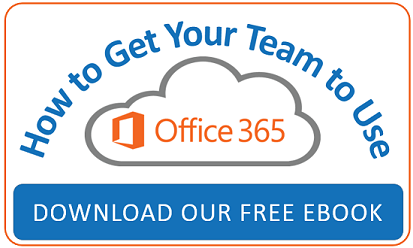 IT professionals and end-users often see technology from different perspectives. You’re likely to be more concerned with all the mechanics and logistics. Conversely, your clients and end-users are scratching their heads. This is a key consideration to include in your Office 365 migration planning. Including user adoption and training activities aids in bridging that chasm, and should be present throughout the migration process.
IT professionals and end-users often see technology from different perspectives. You’re likely to be more concerned with all the mechanics and logistics. Conversely, your clients and end-users are scratching their heads. This is a key consideration to include in your Office 365 migration planning. Including user adoption and training activities aids in bridging that chasm, and should be present throughout the migration process.
Change is hard for some
It’s natural to be intimidated by something new or different. An Office 365 rollout brings with it many enhancements that make life easy for IT pros and end-users alike. Being comfortable with the changes can be a challenge without a warm introduction.
For some end-users, the cloud – and technology relying on it – are still very foreign concepts. Without the tools and confidence to succeed, they could become overwhelmed and not feel comfortable after the migration completes.
The more you can do to help them feel fully supported before, during, and after the migration, the less you’re likely to get flooded with How do I…? calls.
Establish an adoption plan
There are many things to consider in an Office 365 migration plan. None may be as important as ensuring you’ve planned for adoption activities. Without them, you run the risk of losing end-user momentum. Many organizations find success by starting their activity planning with the organization’s leadership members.
Together, you can devise a schedule of activities that include:
- Communications – widespread announcements of what to expect from the new environment, goals of the migration, timelines, etc.
- Engagement events – special seminars and trainings to help familiarize end-users with the Office 365 environment.
- Bottom-up introductions – help end-users build foundations for how they’ll eventually use Office 365, and answer, “What’s in it for me?”
- Top-down introductions – ask leaders and managers to promote the organization’s unified support for the new platform. If leadership believes it, workers will, too.
- Amp up the resources – plan to have training classes, webinars, and self-help resources ready to address common use questions that may will arise.
Building your training plan
Office 365 packs a lot – and ever-expanding – suite of features into its frame. Training end-users to work efficiently with all of it would be impractical at best.
As you work with leadership on the migration strategy, identify and prioritize a list of behavior changes that would benefit the organization. Use that list as your guide to establish your training plan. But don’t try to do it all at once.
Select the first few changes that matter most, educate your end-users until you see the behavior change, then select the next few items on the list. This manageable, iterative approach keeps Office 365 fresh and continually at the center in your end-users’ minds.
KnowledgeWave assists with the training of many Office 365 rollouts. If you’re looking for a starting point, check out our sample training plan for inspiration.
Maintaining interest and adoption
Moving to Office 365 is a big deal for many organizations. It takes substantial planning, organization, and company-wide acceptance to be successful. If mismanaged, your collective effort would be for naught – and you risk declining usage rates. You’ll serve the organization well by sharing the following success tips with leadership during the planning phases:
- Identify a Success Manager (Project Manager) to coordinate all aspects of the migration with every department.
- Elect Champions and Power Users to serve as SMEs for end-users during the initial and ongoing phases of migration.
- Make training as hands-on as possible. Use the tools built into Office 365 to teach the new environment
- Rely on use cases to add relevancy for end-users.
- Gamify the migration. Make the learning fun and you’ll build positive excitement for the change.
It’s easy for IT pros to lose sight of the struggles end-users may encounter with Office 365. Successful migrations include close partnership with leaders, and developing plans that include adoption and training activities. (We've written before about what part IT should play in Office 365 adoption, if you're interested.) Your end-users will appreciate you for being considerate of their challenges, and need you less since you showed them how to work well in the new suite.
You might also like...
 |
 |
 |
| Is Your Team Resisting? Office 365 SharePoint Training Is the Answer | Focus on the Office 365 Features That Matter Most to Your Company | Why You Need an Office 365 Champion (or 10) |








